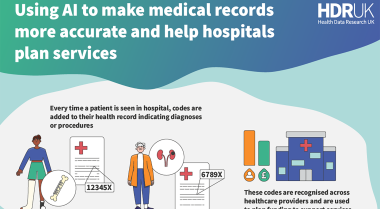Health, educational and employment outcomes among children treated for a skin disorder
25 March 2021
A study linking school and health data for more than 750,000 students provides novel insights on the impact of skin conditions on children’s lives, as well as long-term prospects.

Overview
Skin conditions, including eczema and psoriasis, are the fourth leading cause of disability worldwide, yet little is known about their impact on children’s lives and prospects. Statistician, former HDR UK fellow, and recently appointed University of Glasgow lecturer in public health Dr Michael Fleming took a pioneering approach to studying the issue. The result was one of few studies to link school and health data at a population level.
Challenge
Dr Fleming and colleagues identified a gap in the literature about the impact of skin conditions on children’s lives and long-term prospects. There were several challenges not least because in Scotland, his study area, population level GP data is not available, therefore skin condition sufferers could not be identified on the basis of doctors’ diagnoses. He aimed to find out whether prescribing data can be used as a proxy.
Solution
Since 2014 Dr Fleming has been developing techniques to combine health and educational data. In this study he linked data from four Scotland-wide educational and four health databases. These included information on prescriptions from the Prescribing Information System (PIS) reported by community pharmacies or primary care, hospital admissions, maternity records, death certificates, the annual pupil census, school exam results, absences/exclusions and unemployment.
Learnings
The study examined data for 766,244 schoolchildren, of whom 130,087 (17.0%) were treated for a skin disorder. It was found that prescribing data could be used to ascertain cases in the absence of formal diagnoses.
The findings (published in PLOS One in December 2020) were that children prescribed topical treatment for a skin disorder have an increased risk of school absenteeism and hospitalisation and have greater special educational needs. An association was discovered with increased mortality which the paper’s authors described as “alarming” and in need of further study.
However, there was no evidence of poorer educational outcomes or employment prospects.
Impact and outcomes
The authors hope to see a new approach to the support of children with skin conditions with integrated care from multidisciplinary teams.
More widely the research showed the potential from linking health and education data at a large scale, providing researchers with a large enough cohort to test for statistical interactions and undertake sub-group analyses.
Where many studies could only look at a single educational outcome, this approach successfully examined days absent, exclusions, special educational need, exam results and unemployment.
Further information
Aims and priorities
HDR UK has a series of priorities designed to maximise the impact of health data research in addressing the most pressing healthcare needs.
This study contributed to two of these:
- Improving healthy life expectancy for people living with a common disease
- Developing and applying advanced health data science to address major health challenges.
It also relates to three HDR UK research priorities:
- Improving public health
- Better care
- Applied analytics.
Team and authors
The authors are Michael Fleming, James S. McLay, David Clark, Albert King, Daniel F. Mackay and Jill P. Pell.
Abstract
Background: To compare health, educational and employment outcomes of schoolchildren receiving medication for a skin disorder with peers.
Methods: This retrospective population cohort study linked eight Scotland-wide databases, covering dispensed prescriptions, hospital admissions, maternity records, death certificates, annual pupil census, school examinations, school absences/exclusions and unemployment to investigate educational (absence, exclusion, special educational need, academic attainment), employment, and health (admissions and mortality) outcomes of 766,244 children attending local authority run primary, secondary and special schools in Scotland between 2009 and 2013.
Results: After adjusting for sociodemographic and maternity confounders the 130,087 (17.0%) children treated for a skin disorder had increased hospitalisation, particularly within one year of commencing treatment (IRR 1.38, 95% CI 1.35–1.41, p<0.001) and mortality (HR 1.50, 95% CI 1.18–1.90, p<0.001). They had greater special educational need (OR 1.19, 95% CI 1.17–1.21, p<0.001) and more frequent absences from school (IRR 1.07, 95% CI 1.06–1.08, p<0.001) but did not exhibit poorer exam attainment or increased post-school unemployment. The associations remained after further adjustment for comorbid chronic conditions.
Conclusions: Despite increased hospitalisation, school absenteeism, and special educational need, children treated for a skin disorder did not have poorer exam attainment or employment outcomes. Whilst findings relating to educational and employment outcomes are reassuring, the association with increased risk of mortality is alarming and merits further investigation.



